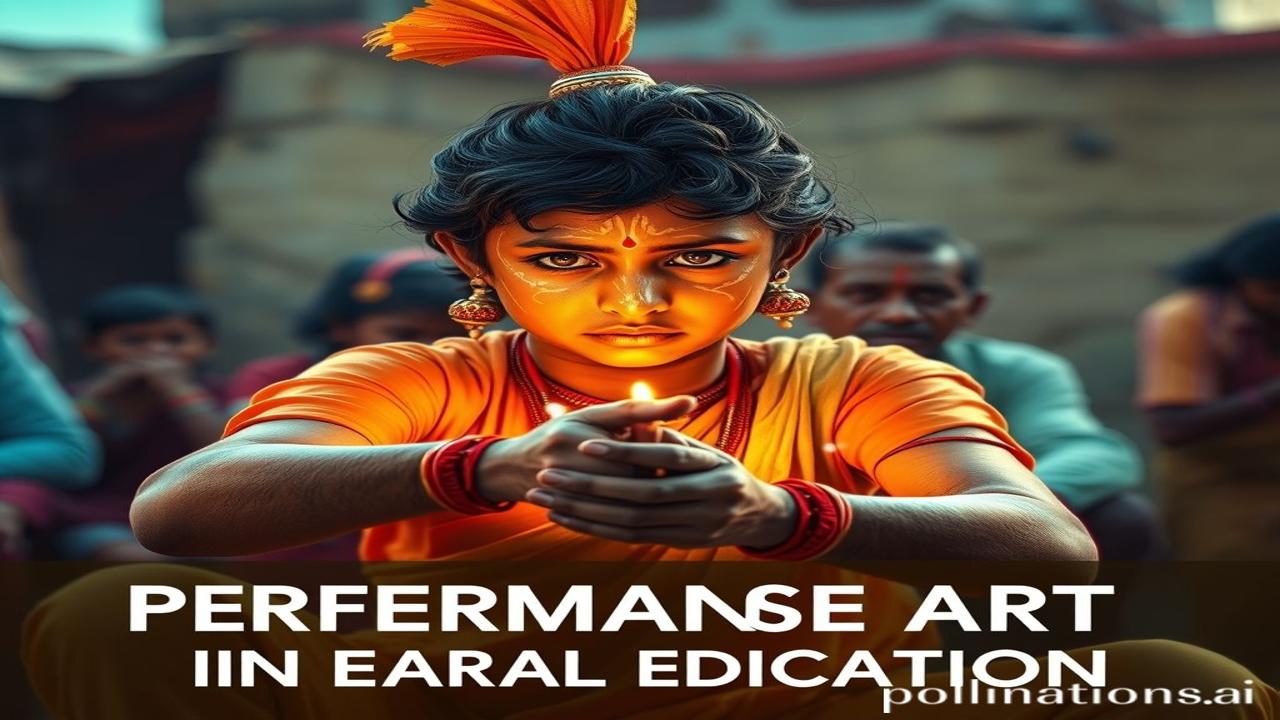Gaon Ki Rangoli: Performance Art Se Seekhte Bachche
Kabhi socha hai, mitti ki khushboo aur nachate hue mor pankhon ke beech chhupi hui education ki kahani kaisi hogi? Imagine a tiny village, where the school bell isn’t just a clang of metal, but the rhythmic beat of a dhol, inviting children into a world where textbooks mingle with dance and drama. Ye hai Bharat ki atoot dhara, jahan parampara aur aadhunikta ek saath chalti hain. Let’s explore how performance art is breathing new life into rural education.
Performance Art: Kya Hai Yeh?
Performance art is a form of art where the artist uses their body, voice, and actions as the medium itself. Unlike painting or sculpture, it’s a live event, often ephemeral and site-specific. Think street plays, folk dances, storytelling through song, even elaborate rituals. In the Indian context, performance art has been a part of our cultural fabric for millennia. From the Natya Shastra, dating back to the 2nd century BC, which codified dance and drama, to the traveling bards who shared epics through song and story, performance has always been a powerful tool for communication and education. Yeh sirf entertainment nahi hai, it’s a way of understanding the world.
Shuruaat Kahan Se Hui?
While ‘performance art’ as a distinct art form gained traction in the West in the mid-20th century, its roots in India run much deeper. Consider the Ramlila, a dramatic reenactment of the Ramayana, which is still performed annually in many villages. Or the Kathputli shows, where puppeteers tell tales of heroism and morality. These weren’t just forms of entertainment; they were crucial ways of passing down history, values, and knowledge from one generation to the next. Hamare gaon mein, performance art hamesha se hi zindagi ka hissa raha hai.
Rural Education Mein Iska Kya Mahatva Hai?
For rural communities often lacking access to formal educational resources, performance art offers a unique and engaging way to learn. Textbooks can feel distant and irrelevant, but a well-performed play about hygiene or a song about environmental conservation can resonate deeply. It fosters creativity, critical thinking, and teamwork, skills that are invaluable in today’s world. This is particularly important because these methods engage the auditory, visual, and kinesthetic senses simultaneously, leading to better retention.
Zameeni Sach: Gaon Ki Zindagi Aur Performance
Imagine a group of children in Rajasthan, huddled around a local artist. Unke chehre par curiosity aur excitement hai. He’s not just telling a story; he’s enacting it, his voice changing with each character, his body moving with the rhythm of the narrative. The story is about water conservation, a crucial issue in their arid landscape.
“Beta, dekho kaise yeh bunda bunda paani kitna anmol hai,” the artist says, miming the digging of a well. The children laugh, imitating his movements, and unknowingly absorb the lesson.
Ma Ganga, a local teacher, uses folk songs to teach math. “Ek ped par do chidiya, doosre par teen. Batao kul kitni chidiya hui?” The children clap their hands, counting along. “Paanch!” they shout in unison.
Performance art empowers these children, giving them a voice and a platform to express themselves. It builds confidence, encourages collaboration, and makes learning fun. It also helps preserve local traditions and cultural heritage, preventing them from fading into oblivion.
Dharohar Aur Pehchan: Aaj Ka Bharat
Today, the importance of performance art in education is being increasingly recognized. Organizations like the National School of Drama and various NGOs are actively working to integrate it into rural schools. We see its presence in street plays addressing social issues, in workshops teaching children traditional art forms, and in festivals celebrating local culture.
Performance art also helps bridge the gap between traditional knowledge and modern perspectives. It allows children to connect with their roots while equipping them with the skills they need to navigate the complexities of the modern world. It’s about honoring Bharatiyata while preparing for the future.
Mazedar Tathya: Log Kya Sochte Hai, Sach Kya Hai?
Log samajhte hain ki performance art sirf entertainment hai. Lekin asli sach yeh hai ki it’s a powerful tool for social change, cultural preservation, and holistic education. It transcends language barriers and connects people on a deeper level. It provides a platform for marginalized voices to be heard and for forgotten stories to be remembered.
Another misconception is that performance art is only for the ‘talented’ few. However, its beauty lies in its inclusivity. Anyone can participate, regardless of their background or skill level. It’s about expression, not perfection.
Drishya Aur Bhavanaen: Gaon Ki Rangoli
Imagine the air thick with the scent of wood smoke and freshly baked bread. The temple bells chime, their sound echoing through the narrow lanes. The walls of the school are painted with vibrant murals depicting local folklore. Children gather in the courtyard, their faces beaming with excitement. The dhol beats, and the performance begins.
The rhythmic clapping, the infectious laughter, the collective gasps of awe – it’s a symphony of sound and emotion. You can feel the energy in the air, the sense of community, the joy of learning. This is rural India at its best, where art and education intertwine to create a brighter future.
Antim Vichar Ya Uddharan
“Sangeet aatma ka bhojan hai, aur natak jeevan ka darpan.” (Music is the food of the soul, and theatre is the mirror of life.) Performance art is not just a form of entertainment; it’s a way of life, a way of learning, and a way of connecting with our roots. It holds the potential to transform rural education and empower generations to come. Let’s embrace its power and ensure that its vibrant colors continue to paint the landscape of India’s future.
